“Q-and-A with Julia Lee Hong on Sprague Gallery,” by Sean Wu
May 27, 2020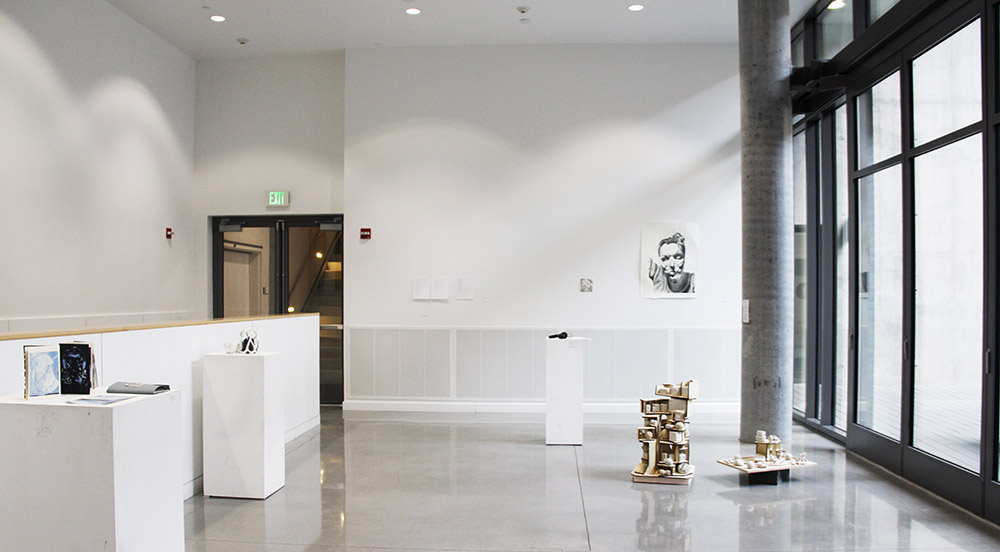
The arts administrator for the College’s Caryll Mudd and Norman F. Sprague Jr. Gallery describes the latest renovations, favorite features, behind-the-scenes details and what’s in store for HMC’s creative space.
Introduce yourself and describe your role in the community.
My name is Julia Lee Hong. I am the arts administrator in the Department of Humanities, Social Sciences, and the Arts at Harvey Mudd College. My projects include administration and publicity of the concert series at Drinkward Recital Hall and exhibition curating at Sprague Gallery. I’ve also been contributing to the gallery renovation with design suggestions.
As Sprague Gallery made renovations since last summer, how has the campus received the new space?
The renovation is ongoing. It may take longer than expected due to the current campus closure. We are still waiting for addition of a few more lights and a poster display case. The walls—those of the gallery space and not the new movable walls—also need to be repaired and painted. With the new walls and pedestals and the first batch of new lights, however, I already felt much more equipped and confident to install the latest exhibition, “Accounts of Their Times.” As for how the new space is received, I would like to find out when the renovation is completed.
The “Accounts of Their Times” exhibit opened early this semester. Give us some background and a little flavor of what it was like behind the scenes.
The gallery has quite regularly hosted exhibitions of student artwork from Art 33 HM Photography. “Accounts of Their Times” is one of them, and there is a set of steps I’ve adopted to curate these exhibitions: first, to review all of the works and statements made; second, to select works based on the visual and conceptual impact they each make; third, to design the exhibition; and finally to draw a conceptual thread among the selected works and write the exhibition title and press release. For me, working in this order is both important and interesting. Important because it helps me and the viewers gain an overview of what different interests and considerations exist within the classroom as a community. Interesting because works from each class/semester would inspire such unique aesthetics and ideas and would somehow result in a conceptual connection of their own—here again is this thought of communities and how shared conversations and influences can shape each one.
As an outsider, whether the connection I draw and the conversations I imagine match what each class really looked like would remain a mystery. But this is what makes the curation of these course exhibitions more interesting. I like to let the works speak and to see that the students are making works powerful enough to speak on their own. It is a true pleasure.
Are there any features of the gallery that you’d like to highlight?
The glass doors. I love that the gallery space opens out to the courtyard and draws natural light and air. Not all galleries are like this. In fact, to have one entire side of the space made of glass—and glass doors that can open—may not be the first choice for many galleries. The glass doors, together with our gallery’s other function as an entrance and pathway to the recital hall, suggest a space that is lived. As an artist, I’ve always believed that art belongs in rooms and spaces that are lived, like homes and offices, lobbies and hallways, and public parks. Come to think of it, even my favorite museums and galleries are those that are housed in mansions and apartments.
Walk us through some of the photos and projects, and share with us some captions that students have written for their work.
I find it most memorable when I can tell from a work that the student has taken the time and courage needed to contemplate and pursue beauty. I can give you a few examples. First, from “Accounts of Their Times,” I remember Nick Richardson and Jessica Drapkin.
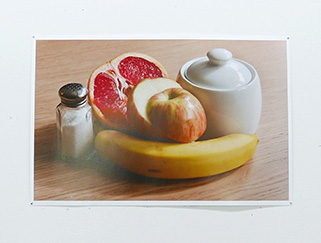
Richardson uses a program he had written to perform Bayesian optimization in order to give his “Salted Fruit” the best configuration of ISO, white balance, aperture and shutter speed and to personally connect to photography as a medium:
I realized that, in amateur fashion, I really only mess with a few settings on my camera ever: ISO, white balance, aperture, and shutter speed… On my Canon EOS60D… naively there are about ~150,000 possible configurations of each of the settings… what’s left is to determine which of these 150,000 configurations is ‘best’ according to your artistic eye. I was kind of kicking myself thinking about this: most of my academic training, and my path post-graduation is exactly concerned with inferring the ‘best’ configuration of some set of parameters to solve a hard problem that you care about. But, I’d never thought of actually applying that framework to photography… for me this was the best photo because I was able to connect photography with something I care/think about a lot. I had fun taking this photo, and it was fun to try something that wasn’t really for anyone else, but just for me. And in some ways, it feels to me like the purpose of this art form is all about connection.
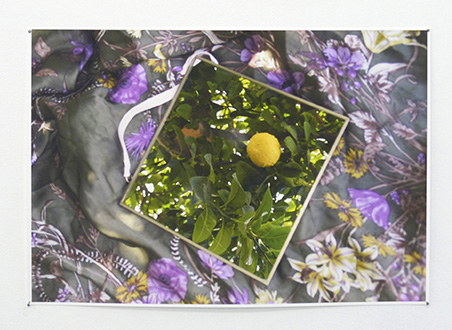
For “Hidden Treasures,” a still life of a mirror on a scarf, Drapkin chooses nature as the setting so that the still life also captures life that so elegantly reveals what is normally hidden, in this case an orange on the bottom branch:
When told to create a colorful still life I knew many would use controlled environments and interesting colors … I wondered if I could get a feeling of control and ‘stillness’ somewhere I did not create myself, somewhere where the elements of my photo would seem less handmade and more natural … I went to the orchard and found this one orange, hidden from sight, hanging from the bottom branch. I laid the scarf and placed the mirror in a position where you can see the orange. I blurred the scarf in some of my shots and found these shots the most interesting. I found the focus on what you don’t see, more calming to look at …This is … a photo that begs its audience to reflect on the way we as people miss these hidden treasures. It is a little crack in the earth that points to the home of a fruit you often find in piles at the grocery store. Suddenly you can understand that what you see in the masses grows alone, in peace, and is taken into this chaos to feed you.
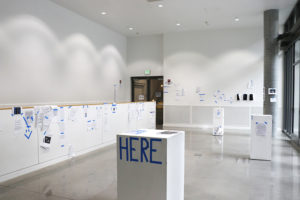
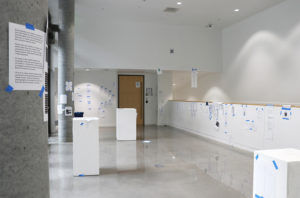
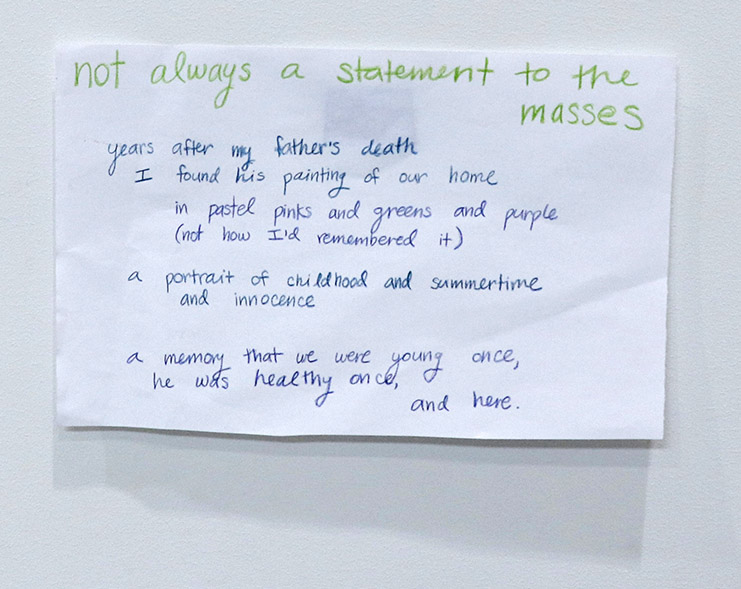
Another work I remember is from “Definition of Art,” an exhibition of student artwork from ART 179E HM, Modern and Contemporary Art Practices (spring 2019), curated by Professor Ken Fandell. Students read aloud a definition of art they had each written and attached it to the gallery. The artist unknown says,
not always a statement to the masses
years after my father’s death
I found his painting of our home
in pastel pinks and greens and purple
(not how I’d remember it)
a portrait of childhood and summertime
and innocence
a memory that we were young once,
he was healthy once,
and here.
What are your aspirations for the art gallery? If there are any plans in the works, what can we look forward to?
Something I envision for the gallery with its feature and function mentioned above is to have it filled with art at all times. For the gallery to greet the students and concertgoers all year long with art and for that part of the campus—around the recital hall, gallery and courtyard—to flourish with art and music. The gallery currently doesn’t have enough resources for this type of more rigorous programming, but I hope it will be possible one day.
When the school decided to close in March due to COVID-19, I was working on a consortium-wide open call for art related to music. It was the first open call to invite faculty and staff in addition to students, and a good number of works were selected. The exhibition was tentatively titled “So she sang.” It will be one of the first things you see in the gallery when the campus reopens. I am also collaborating on a couple of exhibitions initiated by Professor Ken Fandell and involving engineering and computer science. We will know more when we can all finally return to campus, but one thing is certain: we will continue trying to expand the exhibition program and to make the gallery relevant and accessible to all members of the Harvey Mudd community.
Interviewer Sean Wu is a student in the Class of 2023 at Harvey Mudd College and manages the HSA Blog.